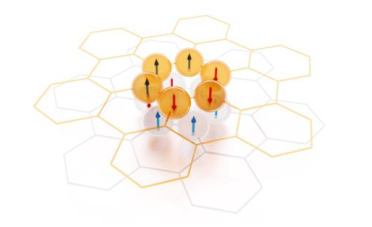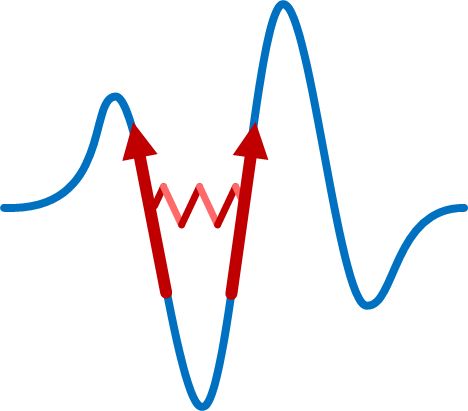
Orateur : Saad Yalouz (Laboratoire de Chimie Quantique de Strasbourg)
Résumé : In the realm of quantum computing, the characterization of many-body systems stands out as one of the most promising applications for emerging quantum platforms. While significant effort has been dedicated to developing near-term quantum algorithms for describing purely fermionic systems (particularly for Quantum Chemistry), there exists a gap in extending beyond the “bare” electronic structure to encompass the influence of an external environment. This gap becomes apparent when considering hybrid “fermion+boson” systems, which naturally arise when the electronic structure of a system interacts with an external bosonic field, such as photons or phonons. The theoretical description of such systems poses a considerable challenge, necessitating the depiction of entanglement between the two types of particles. Addressing this challenge defines an interesting target for quantum computers. In this presentation, I will delve into recent endeavors initiated at the Laboratoire de Chimie Quantique Strasbourg to tackle these questions. Drawing from a polaritonic chemistry problem, I will elucidate how we are currently designing near-term quantum algorithms to describe both ground and excited states in such systems
Contact : Paul-Antoine Hervieux

Sylvain Lecler (ICube)
Séminaire d’information sur l’Institut Photonique Grand Est : il s’agit d’une fédération entre plusieurs laboratoires du Grand Est, et un petit nombre d’entreprises actifs dans le secteur de la photonique.Les universités de Lorraine, Mulhouse, Strasbourg, l’UTT Troyes et Centrale Supelec ont signé l’accord de consortium.
Le but principal de la fédération est de promouvoir la photonique comme un axe scientifique et technologique majeure au niveau de la région, au même titre que les matériaux, l’environnement ou le bio-médicale. C’est un point important au moment des AAP de la région pour les co-financements de thèse ou de post-doc, D’autres opportunités sont les financements de projet par le FEDER.
Le directeur de l’Institut et Marc Sciamanna (Centrale Supelec, Metz). Hervé Rinner (ISL, Nancy) et Sylvain sont les co-directeurs.
Venez profiter de ce séminaire pour vous mettre au courant de cette nouvelle fédération régionale.

Ce travail a été réalisée en collaboration entre le département d’optique non linéaire du laboratoire IPCMS à Strasbourg et, à Aubervilliers, le laboratoire Surface du Verre et Interfaces et le groupe « Procédés et couches extérieures » du département Couches Minces de Saint-Gobain-Research Paris. Il a été encadré par Pierre Gilliot (directeur de thèse).
La soutenance aura lieu dans l’auditorium de l’IPCMS
Une visio est également prévue. Vous pourrez vous connecter au lien suivant :
https://teams.microsoft.com/l/meetup-join/19%3ameeting_MjM4MzYyZDgtZDhhOS00NTg0LWFmM2ItZDMxOTNmYzVmYzUw%40thread.v2/0?context=%7b%22Tid%22%3a%22e339bd4b-2e3b-4035-a452-2112d502f2ff%22%2c%22Oid%22%3a%2247d85de1-5ed5-45ad-b0f1-13def6a55eaf%22%7d

Voir Événement
With the current urgency for green and renewable energies, photovoltaic (PV) technologies seem to be a partially good candidate for this transition. In the scope of the unending battle in improving photovoltaic efficiencies a better understanding of the photophysical processes in PV materials can lead to better device engineering. In collaboration with the LPI (Laboratory of Photonics and Interfaces, EPFL) I conducted a study of the charge carrier dynamics in 2D hybrid perovskites using different spectroscopic techniques such as femtosecond transient absorption and pump probe terahertz spectroscopy to understand the effect of increasing the size of the spacer within these types of samples. These samples show the characteristic signal of a short lived photoinduced stark effect which was assigned to a charge transfer exciton1. To conclude my talk, I will shortly introduce my thesis project. The subject is the use of Thermally Assisted Delayed Fluorescence (TADF) molecules to overcome the roll-off in organic continuous wave lasers.
- « The Impact of Spacer Size on Charge Transfer Excitons in Dion–Jacobson and Ruddlesden–Popper Layered Hybrid Perovskite » George C. Fish, Aaron T. Terpstra, Algirdas Dučinskas, Masaud Almalki, Loï C. Carbone, Lukas Pfeifer, Michael Grätzel, Jacques-E. Moser, and Jovana V. Milić. The Journal of Physical Chemistry Letters 2023 14 (27), 6248-6254
Contact: Loic Mager <mager@ipcms.unistra.fr>

Orateur : Simon Lenne (Magnetism and spintronics group, CRANN, Trinity College Dublin, Dublin, Ireland)
Résumé : There is growing interest in discovering new materials with strong spin-orbit torque (SOT), leading to the study of a wider range of magnetic materials. The harmonic Hall method is a commonly used technique for SOT measurement. However, this method is unable to distinguish between the Nernst effect and SOT. To address this, I developed an extension of the harmonic Hall method which allows for the accurate separation of Nernst and SOT effects. By simultaneously recording and analysing both the longitudinal and transverse signals, this method enables clear and precise separation of the SOT and the anomalous Nernst signals. Furthermore, the numerical implementation of this method enables the study of samples with a more complex anisotropy, such as Mn2RuGa. This approach allows for efficient measurement of SOT, even when signals are small or dominated by the Nernst effect. As a result, a greater diversity of potential materials can be analysed with accuracy.
Contact: Jean Besbas: jean.besbas@ipcms.unistra.fr

Travaux réalisés sous la direction de DR. Jérémie Léonard (IPCMS/DON)
Affiche et résumé

9h30 -10h15: Prof. Stefan Lochbrunner
Institute of Physics and Department of Life, Light and Matter, University of Rostock, Germany
Exciton Dynamics and Migration in Organic Nanostructures
10h30 – 11h15: Prof. Andrea Cannizzo
Laboratory of Ultrafast Molecular Spectroscopy, Institute of Applied Physics, University of Bern, Switzerland.
Ultrafast transport of excitons and energy in antenna systems as multi-chromophoric systems and carbonaceous nanodots
Contact: Jérémie Léonard, IPCMS, Jeremie.Leonard@ipcms.unistra.fr

Abdelghani Laraoui (Department of Mechanical & Materials Engineering, University of Nebraska-Lincoln)
Résumé :
Magnetic microscopy based on nitrogen vacancy (NV) centers in diamond has become a versatile tool to detect magnetic fields with an unprecedented combination of spatial resolution and magnetic sensitivity, opening up new frontiers in biological [1] and condensed physics matter research [2]. In this seminar, I will present two examples of using NV magnetic microscopy in both scanning probe microscopy (SPM) and wide-field microscopy (WFM) geometries to study nanoscale magnetic phenomena in different materials. First, I will discuss NV-SPM measurements of antiferromagnetic (AFM) domains switching in Cr2O3 and B-Cr2O3 thin films and device structures [3, 4]. Cr2O3 is an archetypical AFM oxide that permits voltage-control of the Néel vector. In addition, boron doping increases Néel temperature from 307 K to 400 K and allows realizing voltage controlled Néel vector at zero applied magnetic field, a promising finding to AFM spintronics. Then, I will discuss NV-WFM measurements on individual Fe(Htrz)2(trz)](BF4)] (Fe triazole) spin-crossover (SCO) nano-rods of size varying from 20 to 1000 nm [5]. Fe triazole SCO complexes exhibit thermal switching between low spin (LS) and high spin (HS) states which are applicable in thermal sensors and molecular switches. While the bulk magnetic properties of these molecules are widely studied by bulk magnetometry techniques their properties at the individual level are missing. The stray magnetic fields produced by individual Fe-triazole nano-rods are imaged by NV magnetic microscopy as a function of temperature (up to 150 0C) and applied magnetic field (up to 3500 G). We found that in most of the nanorods the LS state is slightly paramagnetic, possibly originating from the surface oxidation and/or the greater Fe(III) presence along the nanorods’ edges [5].
References: [1] I. Fescenko, A. Laraoui, et al., Phys. Rev. App. 11, 034029 (2019). [2] A. Laraoui and K.
Ambal, Appl. Phys. Lett. 121, 060502 (2022). [3] A. Erickson, A. Laraoui, et al., RSC Adv. 13, 178-185 (2023).
[4] A. Erickson, A. Laraoui, et al., to be submitted to Nat. Mat. (2023). [5] S. Lamichhane, A. Laraoui, et al.,
ACS Nano 17, 9, 8694–8704 (2023).
Contact : Valérie Halté (valerie.halte@ipcms.unistra.fr)

Prof. B. Dietzek – Ivansic, Inst. for Phys. Chemistry, Friedrich-Schiller-University Jena (Germany), Jena Center for Soft Matters
Abstract. Light is ubiquitous and light-driven processes are key, e.g., to the perception of the environment by vision, photosynthesis, to develop specific therapeutic approaches for cancer or to address the global challenge to transform our economy towards renewable energies. Consequently, research on light-activated molecules and materials, i.e., synthesis as well as functional and mechanistic studies on such systems are intensively researched. This talk will focus on two rather unexplored aspects to study light-driven molecular reactivity focusing on the excited-state dynamics in molecular intermediates in complex electron transfer cascades and photo-activated drugs for cancer therapy. I will discuss our experimental approaches, e.g., combining electrochemistry with ultrafast time-resolved spectroscopy, to investigate the light driven molecular reactivity from new viewpoints and highlight implications for photocatalysis and photodrug design obtained from the spectroscopic-mechanistic studies.





